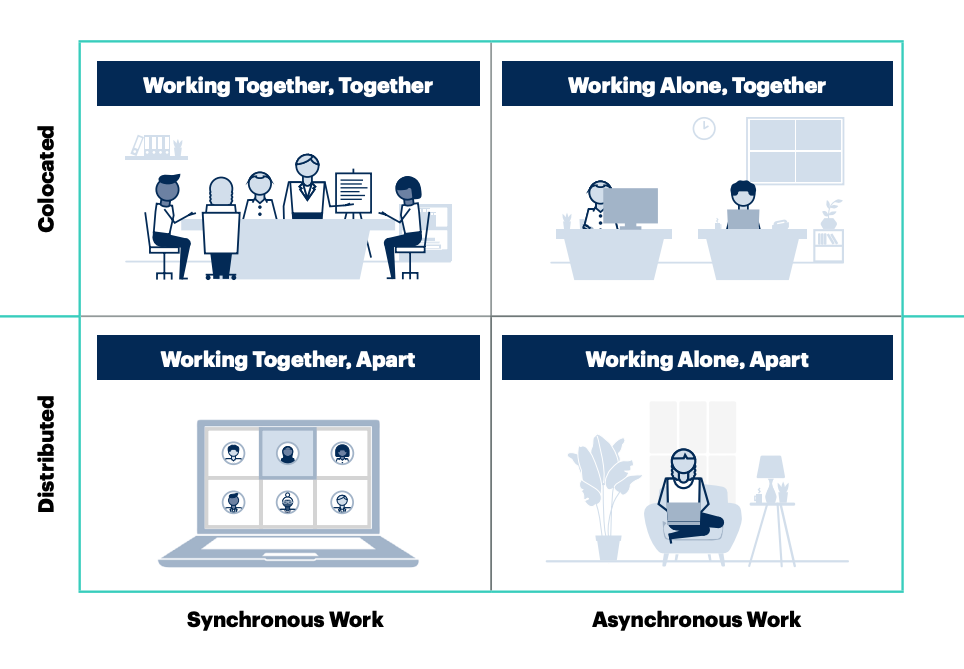“The Future of Work is Now!” is a cliché characterization that seems to point to the swiftness far-off changes have become common in the workplace. With the general upheaval we have experienced, that portrayal has a certain resonance. Specifically, the dramatic increase in remote work has many businesses concerned about how this future-now is impacting their culture and their bottom line.
Consulting firms like Deloitte, McKinsey and Gartner have responded to these questions and the similarities in what their research shows are striking. For the most part, they have not found evidence of a dramatic decrease in productivity or stifling of innovation because workers have not been in their traditional office locations. Part of the reason could be that what we think of as the modern workplace may not have been as modern as we thought.
In a video, “How Will You Reinvent the Future of Work,” Gartner Director of Research Alexia Cambon outlines how assumptions about the “When”, “How”, and “Where” of work were more legacy concepts than necessary constructs in our current environment.
- The “When” of a classic nine to five schedule was instituted during the industrial era when manufacturers needed natural daylight, but we have electricity now and many of us are not on a manufacturing line.
- The “How” of a “culture of meetings” as the way work gets done took hold in the 1950s, but we now have tools to work asynchronously that did not exist then.
- The “Where” of the office as the HQ of work persists, but people have demonstrated they can get work done in other situations.
What we can take from this is that responding to the impact of COVID on our work environment isn’t as simple as trying to virtualize our previous way of working. The 42 million hits for the Google search “Zoom Fatigue” provides one good reason why. Simply changing the mode of the previous way we worked does not produce the same results. But this also raises the possibility our former models of work were outdated.
Instead of thinking of remote work as work performed away from the central headquarters of the office, we may want to consider all the possible modes of work and how they fit into an optimal way of working. One way of visualizing this is by diagramming work as synchronous vs. asynchronous and co-located vs. distributed.
Redesigning Work for a Hybrid Future
Removing co-located, synchronous work as the necessary default for all work opens the possibility that an intentional decision about the collaboration model that best fits the type of work required could result in an increase in productivity and innovation, not a decrease.
While everyone’s work is different, I have found that to be the case for myself. An aspect of my work involves designing solutions to streamline business operations here at Dana-Farber. When gathering requirements and outlining an approach, it is essential that I work closely with all the stakeholders. However, when I begin to develop the application, it’s just as crucial that I have uninterrupted time to work alone. Sometimes, that development happens outside of normal business hours, but often it is those work sessions that provide the impetus to push the project to the next phase.
Learning how to manage work most effectively in each of these quadrants is part of the challenge of our emerging workplaces. Fortunately, we have many collaboration tools to assist with working asynchronously and apart. Determining when and how to use these tools is going to be an essential skill for many workers moving forward. For some, this future was already here long before the pandemic. For others, this may represent a new skill. In any case, deploying these tools in the right situation represents an opportunity to do better work with less friction.
Any individual group’s specific work mode has many complicating factors, and the pandemic may have forced location flexibility in many work environments. But another theme in the research is that employees overwhelmingly value this flexibility. While Zoom meetings are undoubtedly fatiguing, the fact is that now more than ever, the rest of our lives are fatiguing as well. Increased flexibility can help employees do good work and manage their other shifting responsibilities, while also reducing some of that fatigue. And as we find ways for people to be happier and more productive by aligning work with their lives in a way that was not possible fifty years ago, we will have discovered a bright spot on our way to the future of work yet to come.


Great post, Tate! Very timely and insightful.
Fantastic analysis. Determining which work goes in which quadrant and what tools will help is a great next step!
Well said! Perhaps a future post could follow on with recommendations for best collaboration tools to use in each of the 4 quadrants.